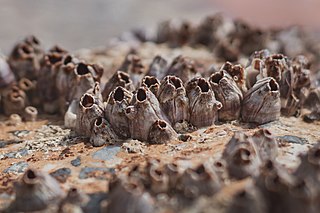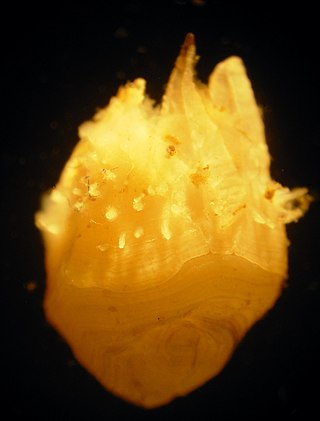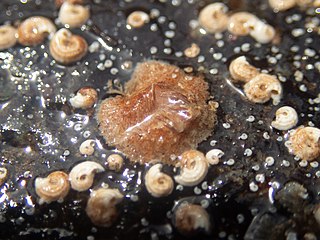
Balanus is a genus of barnacles in the family Balanidae of the subphylum Crustacea.

Thoracica is an infraclass of crustaceans which contains the most familiar species of barnacles found on rocky coasts, such as Semibalanus balanoides and Chthamalus stellatus. They have six well-developed limbs, and may be either stalked or sessile. The carapace is heavily calcified. The group includes free-living and commensal species.

Thecostraca is a class of marine invertebrates containing over 2,200 described species. Many species have planktonic larvae which become sessile or parasitic as adults.

Whale barnacles are species of acorn barnacle that belong to the family Coronulidae. They typically attach to baleen whales, and sometimes settle on toothed whales. The whale barnacles diverged from the turtle barnacles about three million years ago.

Megabalanus is a genus of barnacles in the family Balanidae. Members of the genus grow to 7 cm (2.8 in) in length and inhabit the lower intertidal zone.

Chthamalus is a genus of barnacles that is found along almost all non-boreal coasts of the northern hemisphere, as well as many regions in the southern hemisphere. These small barnacles have been studied in part because of the taxonomic confusion over a group of species that, by and large, are morphologically and ecologically quite similar. In recent years, molecular techniques have identified a number of cryptic species that have been subsequently confirmed by taxonomists using morphological measurements. Most recently the genus has been shown to be paraphyletic, with the genus Microeuraphia nested within Chthamalus.

Acasta is a genus of barnacles in the family Balanidae, containing the following species:

Megabalanus tintinnabulum is a species of large barnacle in the family Balanidae. It is the type species of the genus. The specific name comes from the Latin tintinnabulum meaning a handbell and probably refers to the fact that small groups of barnacles resemble clusters of miniature bells.
The Catophragmidae are a family of barnacles in the superfamily Chthamaloidea with eight shell wall plates, surrounded by several whorls of imbricating plates. The basis is membranous.

Catomerus is a monotypic genus of intertidal/shallow water acorn barnacle that is found in warm temperate waters of Australia. The genus and species is very easily identified by whorls of small plates surrounding the base of the primary shell wall; no other shoreline barnacle species in the Southern Hemisphere has that feature. This species is considered to be a relic, as these plates are found only in primitive living lineages of acorn barnacles or in older fossil species. The fact that this is an intertidal species is unusual, because living primitive relic species are often found in more isolated habitats such as deep ocean basins and abyssal hydrothermal vents.
Rehderella is an unusual and monotypic barnacle genus restricted to Easter Island and Pitcairn Island. Rehderella belyaevi is its only species.

Concavus is a genus of barnacles.

Tesseropora rosea, the rose barnacle, is a species of barnacle found in eastern and southern Australia, and South Africa.

Tetraclita is a genus of sessile barnacles in the family Tetraclitidae. There are more than 20 described species in Tetraclita.

Tetraclitidae is a family of sessile barnacles in the order Balanomorpha. There are about 10 genera and more than 50 described species in Tetraclitidae.

Verrucomorpha is an order of asymmetrical sessile barnacles in the class Thecostraca. They are typically found in deeper and deep-sea habitats. There are 2 families and more than 100 described species in Verrucomorpha.

Microeuraphia is a genus of star barnacles in the family Chthamalidae. There are about eight described species in Microeuraphia.

Verruca is a genus of asymmetrical sessile barnacles in the family Verrucidae. There are about 20 described species in Verruca, around half of them extinct.

Chirona is a genus of acorn barnacles in the family Balanidae. There are about six described species in Chirona.

Pachylasma is a genus of symmetrical sessile barnacles in the family Pachylasmatidae. There are about eight described species in Pachylasma.
















